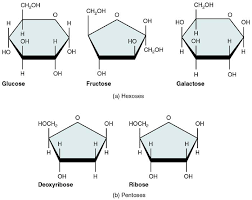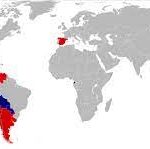The monomers of carbohydrates include glucose, fructose, galactose, ribose, deoxyribose, xylose, and arabinose. These simple units are vital for energy, structure, and communication in cells. Glucose is a primary energy source, while fructose adds sweetness to foods. Understanding these building blocks sheds light on the intricate world of carbohydrate molecules and their significant roles in the body. Unveiling the secrets of these monomers can lead you to a deeper appreciation of how carbohydrates impact your daily life.
Importance of Carbohydrate Monomers
Understanding the significance of carbohydrate monomers is crucial for comprehending the complexities of cellular processes. Carbohydrate monomers, such as glucose and fructose, serve as the building blocks for larger carbohydrate molecules like starch and cellulose. These monomers play a vital role in providing energy for your body. When you consume carbohydrates, enzymes break down these complex molecules into their monomeric form, allowing for easier absorption in your digestive system.
Carbohydrate monomers are also essential for cellular communication. For example, monosaccharides like ribose and deoxyribose are crucial components of nucleotides, the building blocks of DNA and RNA. These sugars help in the transmission of genetic information and the synthesis of proteins within your cells.
Moreover, carbohydrates are involved in cell structure and recognition. Monomers like glycoproteins and glycolipids are integral parts of cell membranes, aiding in cell signaling and interaction. In essence, the importance of carbohydrate monomers extends beyond mere energy provision, influencing various fundamental processes within your body.
Types of Carbohydrate Monomers
Carbohydrate monomers come in various forms, each serving specific functions in biological processes. Glucose is one of the most common carbohydrate monomers and acts as a primary energy source for cells. Fructose, another monosaccharide, is often found in fruits and provides sweetness in foods. Galactose is less common but plays a crucial role in the production of lactose, the sugar present in milk. Ribose and deoxyribose are pentose monosaccharides that are essential components of RNA and DNA, respectively. Additionally, monosaccharides like xylose and arabinose are important for building complex plant polysaccharides.
Moreover, disaccharides such as sucrose, lactose, and maltose are formed by linking two monosaccharides. Sucrose, made of glucose and fructose, is commonly known as table sugar. Lactose, composed of glucose and galactose, is the sugar found in dairy products. Maltose, made of two glucose units, is produced during the digestion of starch. Understanding the different types of carbohydrate monomers is crucial for comprehending the diverse roles these molecules play in biological systems.
Bonding in Carbohydrate Monomers
Examining the bonds present in carbohydrate monomers reveals the structural basis for their diverse functions in biological systems. Carbohydrate monomers are linked together through glycosidic bonds, which are covalent bonds formed by the condensation reaction between the hydroxyl group of one monomer and the anomeric carbon of another.
This linkage results in the formation of disaccharides, oligosaccharides, and polysaccharides. The type of glycosidic bond present between monomers influences the properties and functions of the resulting carbohydrate molecules. For instance, alpha-glycosidic bonds create a more stable structure compared to beta-glycosidic bonds due to their different orientations.
These bonds determine the overall shape of the carbohydrate molecule, affecting its solubility, digestibility, and interactions with other molecules in biological processes. Understanding the bonding patterns in carbohydrate monomers provides insight into how these molecules serve as energy sources, structural components, and cell-cell recognition signals in living organisms.
Functions of Carbohydrate Monomers
Functions of Carbohydrate Monomers encompass a wide range of essential roles in biological systems. Glucose, a common carbohydrate monomer, serves as a vital energy source for your body. When you consume carbohydrates, your body breaks them down into glucose, providing fuel for various cellular processes. Additionally, carbohydrate monomers like fructose are crucial for the synthesis of nucleic acids, the building blocks of DNA and RNA. These monomers play a key role in storing genetic information and transmitting it from one generation to the next.
Carbohydrate monomers also contribute to cell structure and communication. Monomers such as ribose are fundamental components of ribonucleic acids, which are involved in protein synthesis and gene expression. Moreover, monosaccharides like galactose are essential for the formation of glycoproteins and glycolipids, molecules that facilitate cell-cell recognition and signaling. By participating in these diverse functions, carbohydrate monomers are indispensable for the proper functioning of your body at the molecular level.
Examples of Carbohydrate Monomers
Within biological systems, various monomers play crucial roles in the structure and function of cells and molecules. When it comes to carbohydrates, some common examples of carbohydrate monomers include glucose, fructose, and galactose. Glucose is a primary energy source for many organisms and is used in processes like cellular respiration. Fructose, often found in fruits, is a source of sweetness and energy. Galactose, less commonly known, combines with glucose to form the disaccharide lactose found in milk.
These carbohydrate monomers are essential building blocks that form more complex carbohydrates through dehydration synthesis reactions. Glucose, fructose, and galactose are simple sugars, also known as monosaccharides, which can link together to form disaccharides like sucrose (glucose + fructose) or polysaccharides like starch and cellulose. The diverse functions of these carbohydrate monomers contribute to the overall structure and function of carbohydrates in living organisms.
Frequently Asked Questions
How Do Environmental Factors Impact the Synthesis of Carbohydrate Monomers in Living Organisms?
Environmental factors, like temperature and pH, affect how living organisms synthesize carbohydrate monomers. Your cells adjust to these conditions, regulating enzymatic reactions that convert precursors into essential building blocks for carbohydrates crucial to your biological functions.
Are There Any Known Genetic Disorders Related to the Metabolism of Carbohydrate Monomers?
Known genetic disorders related to carbohydrate monomer metabolism can impact individuals. Understanding these conditions and seeking appropriate medical guidance is crucial. Your health and well-being are essential; consult healthcare professionals for personalized advice.
Can Carbohydrate Monomers Be Found in Non-Traditional Sources Such as Fungi or Algae?
Yes, carbohydrate monomers can indeed be found in non-traditional sources like fungi or algae. These alternative sources offer diverse types of monosaccharides that play vital roles in various biological processes, expanding our understanding of carbohydrates.
How Do Researchers Study the Interactions Between Carbohydrate Monomers and Other Biomolecules in the Body?
To study interactions between carbohydrate monomers and biomolecules in the body, researchers employ various techniques like spectroscopy and chromatography. These methods help understand how these building blocks interact, providing insights into crucial biological processes.
Are There Any Potential Applications of Carbohydrate Monomers in the Field of Biotechnology or Medicine?
In biotechnology or medicine, potential applications of carbohydrate monomers are vast. They offer avenues for drug development, biomaterials, and even personalized medicine. Their diverse structures make them valuable tools in advancing healthcare and scientific research.
Conclusion
Now that you know about the monomers of carbohydrates, you can better understand how these building blocks come together to form complex carbohydrate molecules.
By exploring the types, bonding, and functions of carbohydrate monomers, you can appreciate the important role they play in providing energy and structure to living organisms.
Keep in mind that carbohydrates aren’t just a source of fuel, but also essential for various biological processes in the body.


